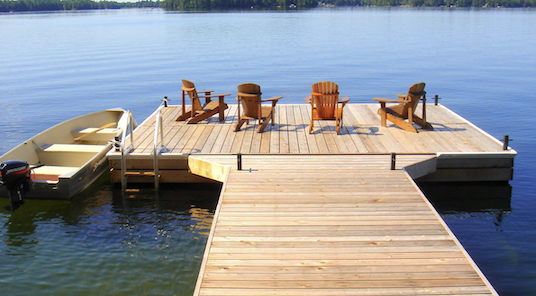DIY Floating Dock-How to Build Framing When Building a Dock
Feb 09, 2021 14:38
It's easy to see that building a floating dock yourself can save you the cost of paying someone to assemble the dock. This article describes how you can save money on both parts and shipping if you choose the right framing material.

Galvanized steel
There are many companies that manufacture galvanized steel frames. These are often sold as part of a kit that includes a float designed to work with the frame. These frames typically range in size from 2x8'to 8'x10'. Each frame is typically a single welded assembly and is hot dip galvanized after welding. Large frames can weigh up to 300 pounds, and depending on where the dock frame is manufactured, shipping can account for a large percentage of the final cost of the dock.
Not only does the considerable weight of the steel dock increase shipping costs, but the 8x20ft steel dock with the proposed levitation weighs 930 pounds before the deck is installed. If your dock has to get out of the water every winter, this may not be the dock for you. Another drawback of steel docks is that the metal is protected by a galvanized coating. The frame cannot be punctured or the protective coating is torn and the metal rusts. This makes it more difficult to add to or change the dock.
Processed timber
Another option is to assemble the dock with locally purchased pressure treated wood. This option usually purchases a hardware kit with galvanized steel brackets and fasteners. Hardware kits are small and relatively inexpensive to ship. Assembling the dock with locally processed wood can save on shipping costs, but wood frame docks can be as heavy as steel docks. Moreover, unlike galvanized steel and aluminum, treated wood is not designed to be continuously submerged. This means that the dock should be built so that the wooden frame is on the float and is completely above the surface of the water. Due to design constraints and the weight of the wood itself, wooden frame docks can be even more difficult to get in and out of the water than steel frame docks.
Aluminum
Aluminum dock frames are significantly lighter than steel or wooden frames. However, some aluminum frames are welding units, which consume a lot of space on the delivery truck and can be expensive to ship. Therefore, depending on where the dock frame is manufactured, shipping can account for a large percentage of the final cost of the dock. Some companies manufacture aluminum dock frames that are fully bolted. These frames can be shipped in small package sets and can be shipped from coast to coast in a cost-effective manner. If you’re looking for the right place where you can get yourself one check out https://www.poralu.com/en/products/floating-docks/. The final dock is also significantly lighter. Most aluminum dock frames are designed to work with custom dock floats (usually sold by dock frame makers), but the makers who designed aluminum frame dock kits that work with 55 gallon polyethylene plastic drums.
There is at least one. Combining an aluminum frame with a plastic drum, the same 8x20ft steel frame dock, which weighs 930 pounds, weighs only 520 pounds. This is an important difference, making it much easier to get the dock in and out of the water.For a variety of reasons, including the weight of the dock and the design of the frame, no floating dock maker has ever installed wheels on the dock.
However, in 2010, at least one manufacturer offered wheels with an aluminum dock frame kit. They are sturdy plastic wheels that allow you to roll up the dock to the beach and store it there during the winter. Alternatively, you can add real highway axles and tires to turn the dock into a floating trailer so that the boat alone can tow directly from a standard slope. This is advantageous if the waterfront property is steep and there is no beach to store the dock during the winter.
Another advantage of the aluminum frame dock is that the corrosion resistance is built into the aluminum so you don't compromise when new holes are drilled for additions or changes. Note: When bolting aluminum for use in salt water or even water with traces of salt, it is recommended to avoid stainless steel fasteners and use aluminum fasteners instead. Stainless steel and aluminum have an electrolyzing effect in the presence of salt, and the aluminum corrodes into white flaky powder.
I hope you find this article helpful. If you decide to build your own dock, you'll better understand the options for framing it.







































































